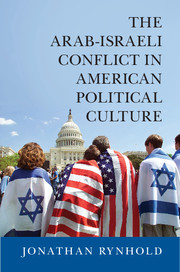Book contents
- Frontmatter
- Dedication
- Contents
- Acknowledgments
- Introduction
- 1 Like U.S.: American Identification with Israel
- Part I Party and Ideology
- Part II Protestants
- Part III Jews
- 6 American Jewish Attachment to Israel: Mind the Gap
- 7 American Jews and the Peace Process: Divided We Stand?
- Conclusion
- Notes
- Bibliography
- Index
7 - American Jews and the Peace Process: Divided We Stand?
Published online by Cambridge University Press: 05 February 2015
- Frontmatter
- Dedication
- Contents
- Acknowledgments
- Introduction
- 1 Like U.S.: American Identification with Israel
- Part I Party and Ideology
- Part II Protestants
- Part III Jews
- 6 American Jewish Attachment to Israel: Mind the Gap
- 7 American Jews and the Peace Process: Divided We Stand?
- Conclusion
- Notes
- Bibliography
- Index
Summary
AIPAC’s great success derives from its capacity to define what it means to be pro-Israel.
—Liz Shrayer, AIPAC political director, 1983–1994AIPAC doesn’t speak for the entire Jewish community.
—Joseph Biden, vice presidential nominee, 2008Introduction
For many years American Jewry stood united behind Israel in its struggle against the Arab states and the PLO. This unity found institutional expression in the pro-Israel lobby spearheaded by AIPAC. However, in the wake of the first intifada, vociferous debate over Israeli policy stirred within the community, and in 2008, amid much fanfare and controversy, a new dovish pro-Israel lobby was established: J Street. It challenged the dominant approach of AIPAC and the mainstream and claimed to represent a large slice of American Jewish opinion. This seemed to signal unprecedented Jewish divisions over the Arab-Israeli conflict. On the other hand, the collapse of the peace process in 2000 was blamed on the Arab side by the overwhelming majority of American Jews. Subsequently, AIPAC’s annual conference set new records for attendance and fund-raising. Renowned academics John Mearsheimer and Stephen Walt claimed that the pro-Israel lobby was all-powerful.
This apparent contradiction begs the following questions: Is American Jewry increasingly divided over the peace process? What changes have taken place in their approach to the conflict? And what are the political implications of these changes? This chapter answers these questions in two parts. The first part deals with American Jewish attitudes towards the conflict. The second part deals with the approach of the organized Jewish community.
- Type
- Chapter
- Information
- The Arab-Israeli Conflict in American Political Culture , pp. 159 - 180Publisher: Cambridge University PressPrint publication year: 2015

